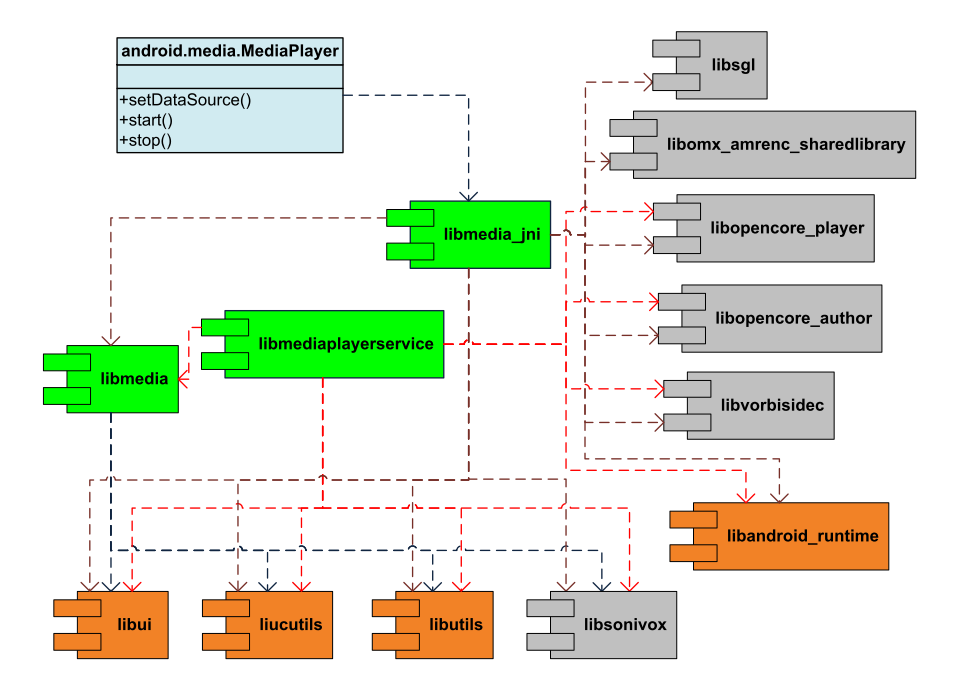understanding the android media framework
2010-10-14 10:50
405 查看
understanding the android media framework
android media framework is built on top of a set of media libraries, including OpenCORE, vorbis
and sonivox. So one of goal of android media framework is to provide a
consistent interface for all services provided by underlying libraries
and make them transparent to users.
The figure below shows the dependency relationships between libraries of the media framework.

In
this figure, green components are media libraries, yellow components
are android internal libraries, grey components are external libraries,
and the light blue class is the java consumer of the media framework.
Except for android.media.MediaPlayer class, all components are
implemented in c or c++.
The core of the media framework is composed
of libmedia, libmediaplayerservice and libmedia_jni. Their codes reside
in frameworks/base/media folder.
libmedia defines the inheritance hierarchy and base interfaces. It’s the base library.
libmedia_jni is the shim between java application and native library. First, it implements the JNI
specification so that it can be used by java application. Second, it implements the facade pattern
for the convenience of caller.
libmediaplayerservice implements some of concrete players and the media service which will manage player instances.
The figure below shows the class hierarchy.

This
is a simplified version of the class hierarchy. Only some core classes
are included. Classes in blue are defined in libmedia, classes in green
are defined in libmediaplayerservice, classes in light yellow are
defined in binder, which implements the IPC on android. And classes in
grey are defined in other libs.
Note the BpInterface and BnInterface
are template classes. Any instantiation of them also inherit the
template argument INTERFACE as well.
In the class hierarchy
diagram, though listed as a separate module, binder is actually
implemented inside libutils component whose source code locate at
/frameworks/base/libs/utils folder.
An interesting
thing to note is in android, the application that intends to show the
media content and the player that actually renders the media content run in different process
. The red line in the sequence diagram below shows the boundary of two processes.

The
figure shows three most common operations, creating a new player,
setting datasource and playing. The last MediaPlayerBase object is the
interface that MediaPlayerService::Client object uses to refer to the
concrete player instance. The concrete player can be VorbisPlayer,
PVPlayer, or any other player, depending on the type of the media to be
played.
When an application creates a android.media.MediaPlayer
object, it’s actually holding a proxy
which can be used to manipulate the concrete player resides in the
mediaserver process. During the whole procedure, two process
communicates with Binder IPC mechanism.
Having
knowledge above, it’s not difficult to understand why MediaPlayer
doesn’t provide an API to use memory stream as source. Because the
memory manipulated by the stream is in the address space of the
application, and it’s not directly accessible by the mediaserver
process.
References:
Google I/O, Mastering the Android Media Framework
android media framework uml diagram
相关文章推荐
- understanding the android media framework
- understanding the android media framework
- understanding the android media framework
- Mastering the Android Media Framework
- Understanding the Framework (理解FMS框架)
- AndroidStudio Frameworks detected: Android framework is detected in the project Configure
- AndroidStudio Frameworks detected: Android framework is detected in the project Configure
- Android Studio-“Android framework is detected in the project”
- The architecture of VLC media framework
- Understanding Android Input Touch Events System Framework (dispatchTouchEvent, onInterceptTouchEvent
- Android Studio 出现Frameworks detected:Android framework is detected in the project Configure
- A First Look at the Android Testing Framework
- The architecture of VLC media framework(VLC媒体框架结构介绍)
- Android - How to direct the audio data from MediaRecorder as the input of ffmpeg command via Pipe?
- android mutilmedia framework 简述
- AndroidStudio Frameworks detected: Android framework is detected in the project Configure
- 【Android Studio】Frameworks detected: Android framework is detected in the project Configure
- Google I/O 2008-Inside the Android Application Framework
- (1)The Android Application Framework Overview
- 提示错误:Frameworks detected: Android framework is detected in the project Configure
